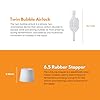Essential Terms for Homebrewers
Whether you're a complete beginner or a seasoned homebrewer, understanding the common terminology used in brewing is essential for creating a delicious and successful batch of beer. From malts to hops to fermentation, this article will guide you through the basics of brewing and equip you with the knowledge you need to start your own brewing journey. So grab a cold one (or a hot cup of tea, if you prefer) and get ready to dive into the wonderful world of brewing!
Essential Equipment and Supplies
Before you begin brewing, it's important to have the essential equipment and supplies on hand. Here are some key items you'll need:
- Fermenter: A vessel where wort (unfermented beer) will be stored during the fermentation process. Options include plastic or glass fermenters.
- Airlock and Stopper: These are used to seal the fermenter and allow carbon dioxide to escape during fermentation. Make sure to sanitize them before use.
- Brew Kettle: A large pot where you'll boil your wort and add hops and other ingredients. A 5-gallon kettle is a good size for beginners.
- Thermometer: Essential for ensuring that you're boiling your wort at the right temperature.
- Hydrometer: Measures the specific gravity of your wort, which is important for calculating alcohol content and determining when fermentation is complete.
- Sanitizer: Keeping all your equipment sanitized is crucial for preventing contamination and ensuring a successful brew.
The Brewing Process
The brewing process can be broken down into several key steps: mashing, boiling, fermenting, and bottling.
Mashing
Mashing involves steeping grains in hot water to extract sugars, creating a sweet liquid called wort. This step is crucial for developing the base flavors of your beer.
Boiling
Boiling involves adding hops and other ingredients to the wort to create the desired flavor profile. This process also sterilizes the wort, making it safe for fermentation.
Fermenting
Fermenting is the process of converting sugars into alcohol through the use of yeast. The wort is transferred to a fermenter, yeast is added, and the mixture is allowed to ferment for a specified period.
Bottling
Bottling is the final step where the beer is transferred into bottles for carbonation and storage. Proper sanitization during this step is essential to avoid contamination.
Popular Beer Styles and Recipes
Now that you have a basic understanding of the brewing process, it's time to explore some recipes for different types of beer. From a classic IPA to a refreshing wheat beer, there are endless possibilities when it comes to homebrewing. Don't be afraid to experiment and try out new recipes to find your perfect brew.
IPA Recipe
- Ingredients:
- 8 lbs Pale Malt Extract
- 1 lb Crystal Malt
- 1 oz Cascade Hops
- 1 oz Centennial Hops
- 1 packet American Ale Yeast
- Instructions:
- Steep the crystal malt in 2 gallons of water at 155 degrees Fahrenheit for 30 minutes.
- Remove the grains and add the malt extract.
- Bring to a boil, then add the hops. Boil for 60 minutes, then cool and transfer to a fermenter.
- Add yeast and let ferment for 2 weeks. Bottle or keg and enjoy!
Wheat Beer Recipe
- Ingredients:
- 6 lbs Wheat Malt Extract
- 1 lb Light Dry Malt Extract
- 1 oz Hallertau Hops
- 1 packet German Wheat Yeast
- Instructions:
- Bring 3 gallons of water to a boil.
- Add the malt extracts and return to a boil.
- Add the hops and boil for 60 minutes.
- Cool the wort and transfer to a fermenter.
- Add yeast and let ferment for 2 weeks. Bottle or keg and enjoy!
Tips and Techniques for Successful Brewing
Brewing beer is both an art and a science. Here are some tips and techniques to help improve your brewing skills:
- Keep Your Equipment Clean and Sanitized: Proper sanitization is crucial to prevent contamination and off-flavors in your beer.
- Use Fresh, High-Quality Ingredients: Using fresh, high-quality grains, hops, and yeast can make a significant difference in the taste of your beer.
- Monitor and Adjust Temperature: Temperature control is crucial for successful brewing. Make sure to monitor and adjust the temperature throughout the process.
- Keep Track of Your Brewing Process: Take detailed notes to make adjustments for future batches. Practice makes perfect!
Keeping Up with the Craft Beer Scene
Craft beer has exploded in popularity in recent years, with new breweries and styles popping up all over the world. As a homebrewer, it's important to stay informed about the craft beer industry to keep up with the latest trends and techniques.
- Online Communities and Forums: Join online communities and forums to connect with other brewers and learn from their experiences.
- Beer Festivals and Events: Attend beer festivals and events to taste a variety of craft beers and network with other brewers.
- Industry Publications and Influential Figures: Subscribe to industry publications and follow influential figures in the craft beer world to stay updated on the latest trends and developments.
Good Job!
Congratulations on completing this crash course in brewing terminology! We hope this article has provided you with the knowledge and confidence to begin your homebrewing journey. Remember, the key to successful brewing is practice, patience, and a passion for good beer. By following this guide, you'll be well on your way to mastering the basics of brewing terminology and creating delicious homebrews. Happy brewing! Cheers!

























































